5 June, 2000
The MocNess Monsters
June 5, Monday
How do you catch monsters at sea? With a monster net, of course!
The "monsters" that marine biologist Peter Lane is interested in catching
are actually tiny animals called zooplankton. Zooplankton live in oceans all
over the world and are an important source of food for fish, whales, and
other marine mammals. They are some of the most abundant animals in the
world. Although they don't look very impressive to the naked eye, when
viewed under a microscope, they look a lot like monsters from the deep!
Today Janice and I helped Peter catch the little critters with a piece of
equipment called the MOCNESS. MOCNESS is actually an acronym that stands for
"Multiple Opening and Closing Nets and Environmental Sampling System.” Nine
nets hang off a metal frame that is lowered into the water and towed behind
the ship.
Peter is interested in finding out what kinds of zooplankton are here in the
Davis Strait. He also wants to know how many there are, and where they are.
>From previous MOCNESS experiments, scientists have already learned that the
zooplankton like to hang out together in large groups wherever they find
phytoplankton (microscopic plants) to eat. They also know that zooplankton
usually rise up to the surface at night to feed and lay their eggs. During
the day, they go deep in the ocean where they can hide from birds and other
predators.
It took Peter several days to get the MOCNESS ready to go. When it was time
to conduct the experiment, the nets were lowered into the water with a
winch. Computerized sensors attached to the frame told Peter how deep the
MOCNESS is in the water. Each net can be opened and closed at different
times. Peter can decide when to open and close the nets.
For this experiment, the MOCNESS was lowered 500 meters down into the water.
Peter opened the first net at the bottom and waited as the winch raised the
MOCNESS up. When it reached 400 meters, Peter sent a signal to sensor that
closed that net. That way, he could catch zooplankton that were hanging out
in the water at depths between 400 and 500 meters. He continued this process
as the MOCNESS was slowly raised to the surface.
When the MOCNESS was finally lifted back onto the Healy, I helped Peter wash
out the nets into special buckets called "cod ends" that are attached to the
end of each net. Then we removed the cod end from the net so we could see
what we had caught. The water in the cod ends looked like pea soup, only it
was pink instead of green! We had caught thousands of zooplankton called
copepods. They looked like miniature shrimp. There were other critters, too.
We helped Peter pack the cod ends into crates and carry them into the
laboratory where we could look at them under the microscope. To see pictures
of the "MOCNESS Monsters, click on Janice's page:
Janice's Entry
Today.
DAILY DATA LOG (6/05/00)
Air Temperature: 2 degrees C / 36 degrees F
Clear skies, sunny
Latitude 57N
Longitude 55W
Sunrise 5:04
Sunset 10:33
Actually, it never got DARK last night. For an hour or two in the middle of
the night, it was more like dusk than night. But even at midnight you could
see light on the horizon.
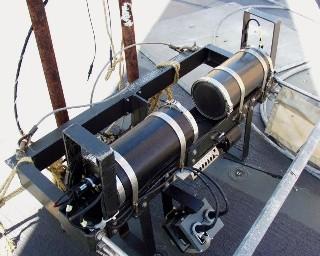
These instruments tell Peter how deep the nets are in the water.
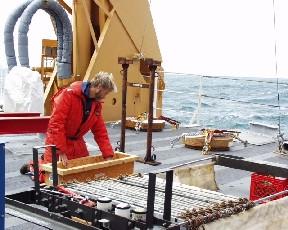
Peter has the frame ready for the nets to be attached.
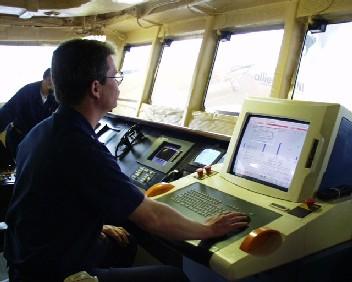
Marine Science Technician Glen pays out wire at a speed that Peter determines.
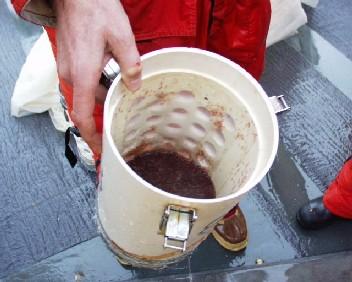
Water in the cod end is teeming with life.
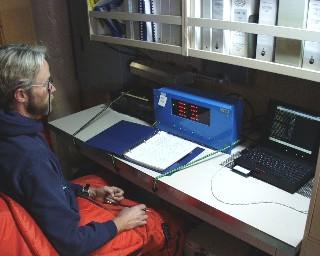
Peter checks the monitors while MOCNESS is collecting samples.

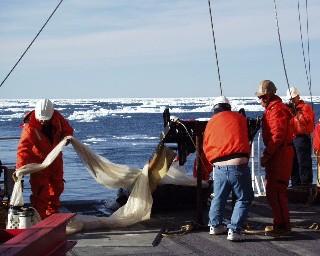
The MOCNESS is sampling in ARCTIC waters.
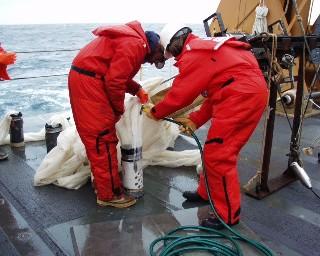
I am helping Peter to rinse out the nets. He wants all the samples in the cod ends at the bottom of the net.
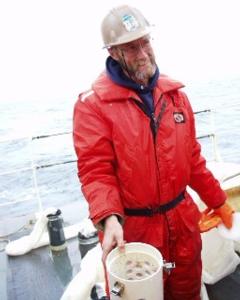
Peter with his zooplankton "catch"
Contact the TEA in the field at
.
If you cannot connect through your browser, copy the
TEA's e-mail address in the "To:" line of
your favorite e-mail package.
|
